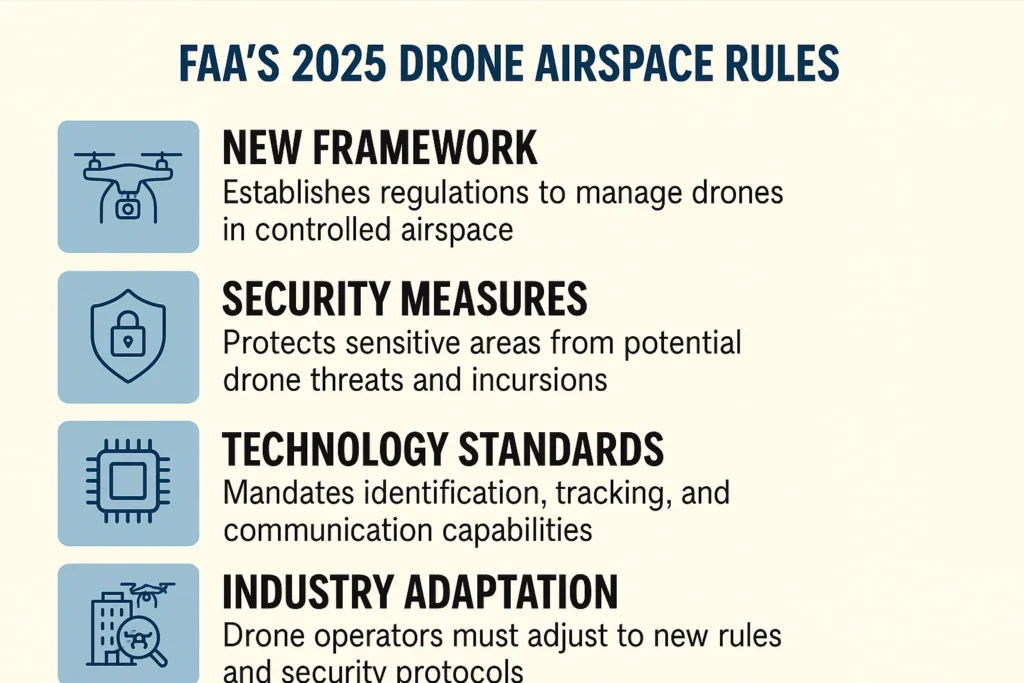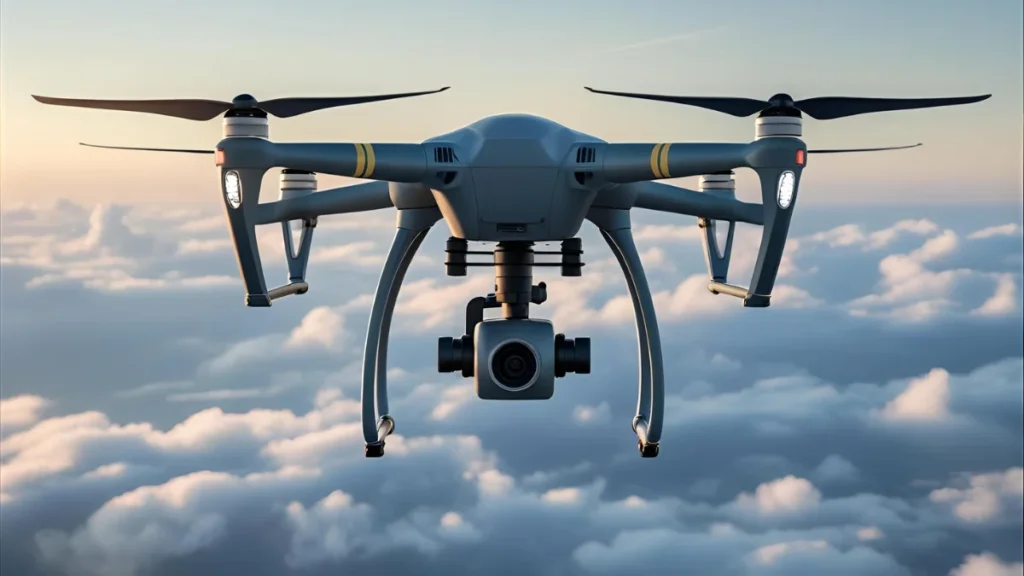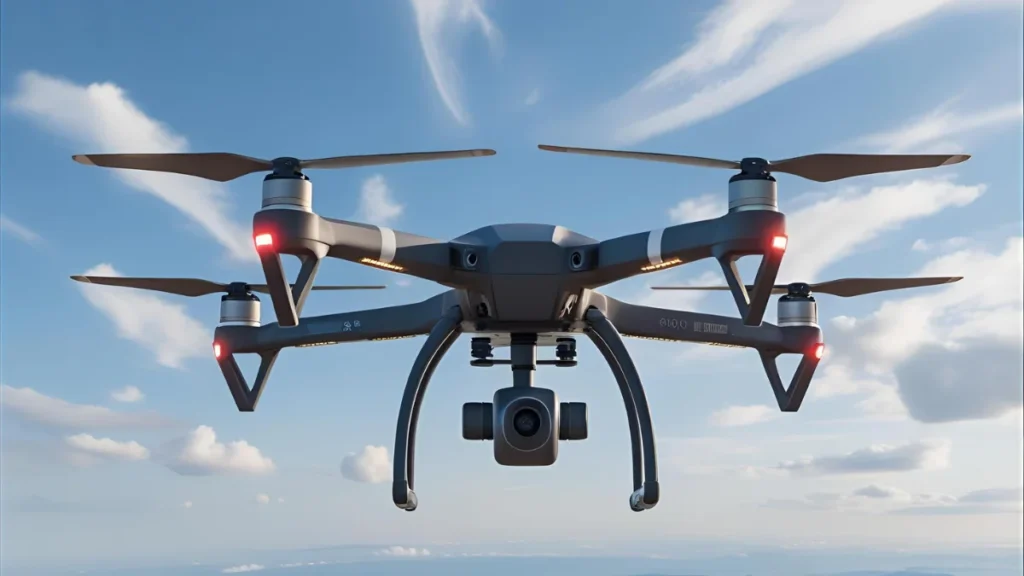FAA drone airspace rules 2025 enhance national security and safety while balancing growth in the U.S. drone economy.
Key Takeaways of FAA Drone Airspace Rules
- FAA introduces stricter drone rules near critical infrastructure and sensitive airspace, effective November 2025.
- Policy mandates real-time Remote ID, dynamic airspace restrictions, and certification for high-risk operations.
- New rules reflect collaboration with DHS, DoD, and NASA, highlighting national security priorities.
- Industry groups raise concerns over compliance costs and unclear federal-local jurisdiction boundaries.
- Policy aims to preserve drone industry growth while protecting aviation safety and homeland security.
Understanding FAA Drone Airspace Rules: An Introduction

In 2025, the FAA finds itself navigating a complex airspace — not just physical, but political and technological.
As commercial drone activity surges across industries from agriculture to logistics, concerns about unauthorized flights near airports, military bases, and energy facilities have risen sharply.
Responding to multiple near-incidents and national security warnings, the FAA has released a sweeping new policy framework that restricts drone operations around high-risk zones.
But with innovation on the line, will these rules ground the industry or guide it to safer skies?
Policy Overview: What’s Changing?
The FAA’s “Enhanced Sensitive Airspace Operations Rule” (ESAOR) includes the following key elements:
- Mandatory Real-Time Remote ID transmission with verified operator identity for drones above 250g
- Geofencing compliance certification for all commercial drones, particularly around:
- Airports
- Military installations
- Power plants
- National landmarks
- DANS, or the Dynamic Airspace Notification System, integrates for live updates on restricted zones
- Tiered operation licensing for high-risk missions (e.g., delivery near critical infrastructure)
- Expanded authority for local law enforcement to intercept or ground unauthorized drones
The rule builds upon 2021’s Remote ID framework but adds enforcement, accountability, and dynamic restrictions in collaboration with DHS, NORAD, and NASA’s UTM (Unmanned Traffic Management).
Background & Context of FAA Drone Airspace Rules
In early 2024, multiple drone incursions over nuclear plants in Arizona and a near-miss with a commercial aircraft departing Atlanta spurred a joint review by the FAA, DHS, and the Department of Defense.
At the same time, the drone economy was booming — 1.2 million registered drones in the U.S. by late 2024, with Amazon, Zipline, and agricultural fleets expanding rapidly.
The outdated airspace governance model struggled to balance innovation with increasing risk.
This policy marks a pivotal shift — from passive regulation to active airspace management.
Stakeholders & Affected Parties
- Drone Operators: Must upgrade to Remote ID-compliant hardware, maintain flight logs, and comply with dynamic zones.
- Drone Manufacturers: Required to build in geofencing and DANS-compatible software.
- Critical Infrastructure Operators: Gain protection, but may face coordination burdens with drone service providers.
- Law Enforcement: Empowered but requires technical training and federal support.
- Recreational Flyers: Allowed in designated zones but must register and comply with altitude limits.
Industry & Expert Reactions to FAA Drone Airspace Rules
“We support safety, but innovation can’t be held hostage to bureaucracy,” said Carlos Mendez, CTO at DroneX Systems.
“This is the FAA’s strongest signal yet that drones are no longer toys — they’re aircraft, and the airspace is real estate,” noted Dr. Jane Holloway, aviation law professor at Embry-Riddle Aeronautical University.
The Association for Uncrewed Vehicle Systems International (AUVSI) has pushed for more clarity on how state and federal jurisdictions will coexist, particularly in urban drone corridors.
Implementation Challenges & Risks
- The cost of compliance for small commercial operators could stifle local drone services.
- Patchwork enforcement between state and federal agencies could confuse operators.
- Technology gaps: Legacy drones lack compatibility with dynamic airspace feeds.
- Risk of overreach: Privacy and civil liberty advocates warn against mission creep in surveillance zones.

Solutions & Best Practices in Development of FAA Drone Airspace Rules
- FAA DroneZone 2.0: A centralized, app-based interface for all drone flight planning, dynamic updates, and licensing.
- Public-private working groups for real-time testing in urban air mobility corridors (e.g., Dallas, Phoenix, Pittsburgh).
- Drone Law Training for local police departments and airport security.
- Government-backed upgrade grants for small business drone operators to retrofit compliant hardware.
Future Outlook of FAA Drone Airspace Rules Governance
These rules are expected to be the precursor to full-scale national airspace integration, especially for drone delivery, aerial taxis, and emergency response operations.
By 2030, the FAA envisions a tiered national airspace system where traditional and unmanned aircraft coexist through shared digital infrastructure.
Internationally, ICAO may use this policy as a case study to update its own Remotely Piloted Aircraft Systems (RPAS) framework, helping to harmonize standards globally.
Suggestions for Amendments to FAA Drone Airspace Rules
- Extended compliance timelines for micro-operators under 2-person businesses.
- Localized sandbox zones where pilots can test advanced drone applications with reduced red tape.
- Clearer interagency playbook to define who’s in charge of drone enforcement at federal vs. state levels.
These changes would reduce confusion, foster innovation, and uphold safety without smothering the growing drone economy.
Conclusion: A Safer Airspace for All — If We Can Navigate the Turbulence
The FAA’s 2025 drone policy doesn’t just tighten rules — it redefines the concept of airspace in the digital era.
While challenges around compliance, cost, and clarity remain, the move signals a maturing industry and a government prepared to embrace aerial innovation — responsibly.

The skies may be crowded, but with thoughtful governance, they can be both safe and free.
Gas Turbine Combustion 1st Edition
- by Arthur Lefebvre (Author)
- Rating 4.3 out of 5 stars (5)
- Language : English
- Print length : 531 pages
- Item Weight : 1.78 pounds
- Dimensions : 1 x 6.25 x 9.25 inches
Last update on 2025-12-27 / Affiliate links / Images from Amazon Product Advertising API

